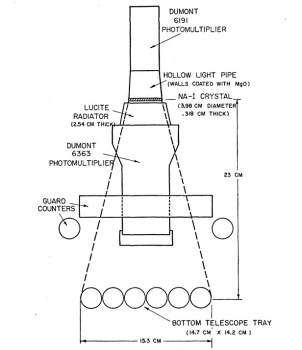Purpose of the flight and payload description
The payload was a combination of Cerenkov and scintillation detectors used to study spectral cutoffs as a function of latitude and to observe some aspects of temporal variations at high altitude of the alpha particles of the primary cosmic radiation.
The instrument which can be seen described in the scheme at left was a three-element telescope containing a crystal scintillation counter, a Lucite Cerenkov counter, and a Geiger counter tray. The scintillation crystal and the Geiger counter tray were the defining elements of the telescope. All these elements were enclosed in an airtight aluminum cylinder.
For each particle which traversed these elements, the outputs from the Cerenkov counter and the scintillation counter were recorded. A notation was also made when a telescope event was accompanied by the triggering of more than one counter in the tray or by one of the ring of guard counters. The data were recorded on a continuously moving film with an accurate time base superimposed. These data were then reduced by measuring for each event the pulse height from the scintillation counter and from the Cerenkov counter.
These measurements were recorded on a suitable two-dimensional data grid.
Details of the balloon flight
Balloon launched on: 9/7/1956
Launch site: Einarson Flight Station, International Falls, Minnesota, US
Balloon launched by: Winzen Research Inc.
Balloon manufacturer/size/composition: Zero Pressure Balloon Winzen - 120 ft (1.2 Mils.)
Balloon serial number: 120-120-V-28
Flight identification number: WRI 715
End of flight (L for landing time, W for last contact, otherwise termination time): 9/7/1956
Payload weight: 276 lbs.
Overall weight: 605 lbs.
External references
- Flight Summary Log Winzen Research Inc. report (1963)
- Physicists Hunt Skyhook Rig The Daily Iowan, September 12, 1956
3705If you consider this website interesting or useful, you can help me to keep it up and running with a small donation to cover the operational costs. Just the equivalent of the price of a cup of coffee helps a lot.


